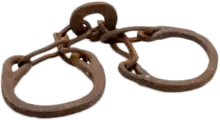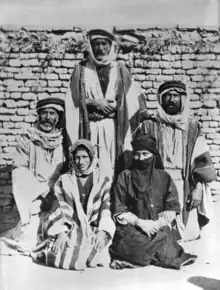Slavery in Iraq
Slavery existed in the territory of the modern state of Iraq until the 1920s. The are later to become the modern state of Iraq was a center of the Abbasid Caliphate (750–1258), the are was a major slave trade destination, and slaves were imported to Iraq from the East along the Volga trade route, from the West via the Red Sea slave trade, and from the South from the Indian Ocean slave trade.
| Part of a series on |
| Slavery |
|---|
 |






Under the First World War, Ottoman Iraq came under rulership of the British, who disliked slavery. Slavery was formally abolished in Iraq in 1924. Iraq was the first Gulf state, in which slavery was banned.
In the 21st-century, Islamic terrorists again practiced slavery in areas under their control in Syria and Iraq.
History
Abbasid Caliphate (750–1258)
Slave trade
The slave trade had been big also during the Umayyad Caliphate, but then, it had been fueled by war captives and people enslaved as tax levy, but during the Abbasid Caliphate the slave trade was supplanted by people bought through commercial slave trade provided for the slave markets in Basra, Baghdad and Samarra.[1]
Slaves were transported in the 9th-century from the Red Sea slave trade to Jeddah, Mecca and Medina, and by caravan over the desert to Baghdad; as well as via the Indian Ocean slave trade by boat through the Persian Gulf to Ras al Khymah, Dubai, Bandrar Abbas, Bushine and Basra.[2][3]
A third slave trade route was the Volga trade route, in which enslaved Europeans were sold in Russia and shipped down to Baghdad via Persia and the Samanid Empire.
Female slaves
Female slaves were primarily used as either domestic servants, or as concubines (sex slaves), while male slaves were used in a number of tasks.
The slave trade in the Muslim world focused on women for used of domestic servants and sex slaves.[4] Women were trafficked to the royal Abbasid harem from Europe via the Volga trade route, as well as from Africa and Asia.[5] The royal harem was used as a role model for the harems of other wealthy men. Women from Europe, Central Asia, Asia and Africa was used as sex slaves and domestic servants within the royal and the lesser harems.
Male slaves
The use of male slaves were far more varied. Since eunuchs lacked family of their own and was unable to have children, they were considered highly thrustworthy, and used as harem guards, as guards at mosques and holy sites, as administrators and family stewards.[3]
Slave laborers were used in cash-crop production, in the silk textile industry, in salt production and land reclamation, in cotton and sugar production especially in the area of the big slave market center of Basra. Slave laborers were kept in big work camps, and often had to be replaced by new slaves through the slave trade, since the marschlands in Mesopotamia caused slaves to die in large numbers from malaria, and slaves were not allowed to marry or have children.[1] Around 15,000 slaves were estimated to be kept in the Basra area at any given time, and that a quarter of the labor force consisted of slave labor.[1] Contemporary writers in the late 9th-century estimated that there were around 300.000 slaves in Iraq.[1] The harsch condition resulted in a big slave rebellion known as the Zanj Rebellion, which lasted between 869 and 883.
From the early 9th-century, slaves, specifically Turkish slaves, were also employed as slave soldiers.[1]
Thousands and possibly millions of Africans, Berbers, Turks, and Europeans from Northeastern Europe (saqaliba) are estimated to have been enslaved in this time period.[1]
Ottoman Iraq (1534–1920)
Slave trade
During the 19th-century, the slave route from Africa to Ottoman Iraq from the East coast of Africa via the Indian Ocean slave trade and the Red Sea slave trade via the Persian Gulf and by caravans over the desert respectively.[6]
In 1847, the British consulate in Baghdad reported:[7]
- The average import of slaves into Bussorah is 2000 head - in some years the numbers have reached 3000, but for the year 1836, owing, it is supposed, to the discouragement which the traffic has sustained from the iman of Muscat, no more than 1000 slaves were imported. [...] Of the slaves imported, one half is usually sent to the Muntefick town on the Euphrates, named Sook-ess-Shookh, from whence they are pread all over Southern Mesopotamia, and Eastern Syria; a quarter are exported directly to Bahgdad and the remainder are disposed of in the Bussorah Market.
During the Armenian genocide in 1915-1923, many Armenians, primarily women, girls and boys under the age of twelve, were enslaved ny Muslims in Ottoman Syria and Iraq.[8] Armenian girls and children where sold from Syria to harems and brothels in Ottoman Iraq, such as Bahgdad.[9]
Throughout the genocide the men were given free licence to do as they pleased with Armenian women.[10] Armenian women and children were displayed naked in auctions in Damascus, where they were sold as sex slaves. The trafficking of Armenian women as sex slaves was an important source of income for accompanying soldiers. In Arab areas, enslaved Armenian women were sold at low prices. The German consul at Mosul reported that the maximum price for an Armenian woman was "5 piastres"(about 20 Pence Sterling at the time).[11]
Function and conditions
Female slaves were primarily used as either domestic servants, or as concubines (sex slaves), while male slaves were used in a number of tasks.
Slaves in Islam were mainly directed at the service sector – concubines and cooks, porters and soldiers – with slavery itself primarily a form of consumption rather than a factor of production.[12] The most telling evidence for this is found in the gender ratio; among slaves traded in Islamic empire across the centuries, there were roughly two females to every male.[12] Outside of explicit sexual slavery, most female slaves had domestic occupations. Often, this also included sexual relations with their masters – a lawful motive for their purchase and the most common one.[13][14]
Activism against slave trade
After the British occupation of Ottoman Baghdad during World War I in 1917, the British liberated 80 enslaved Armenian girls from Muslim households, and in 1919, the British reported that there were around 1000 Armenians in Baghdad and that their number increased all the time when more ensalved Armenian girls and children were liberated from various Arab housholds and villages.[15]
After the truce, the Ottoman government in Constantinople ordered the local governors in the Ottoman Empire to localise (enslaved) Christian women and children and hand them over to Christian bodies.[16] Egyptian Armenians organized squads to resque enslaved Armenians from Beduins in Syria and Mesopotamia (Iraq); one of these, led by Rupen Herian, raported that they hade liberated 533 enslaved women and children between June and August 1919.[16]
Several actors, among them the League of Nations, the British Friends of Armenia, the Syrian Armenian Relief Society and Karen Jeppe, worked to ensure the liberation of the enslaved Armenians, some of them active as late as in the 1930s.[17] In her report to the League of Nations in Geneva in May 1927, Karen Jeppe stated that 1600 enslaved Armenians had been liberated from slavery in a five year period, foremost from Syria;[17] however, many thousands of Armenians remained in slavery.[17]
Abolition
In 1921, former Ottoman Iraq was transformed in to the Kingdom of Iraq under British protection. The new Iraqi ruler was thus dependent upon support from the British, who disliked slavery.
Slavery was formally banned in Iraq in 1924,[18][19] by royal decree issued by king Faisal I of Iraq.[20]
Many members of the Afro-Iraqi minority are descendants of the former slaves.
21st-century
For the revival of slavery in territories in Iraq and Syria occupied by the Islamic State in the 21st-century, see Slavery in 21st-century jihadism and Genocide of Yazidis by the Islamic State#Sexual slavery and reproductive violence.
See also
References
- van Bavel, B. (2019). The Invisible Hand? How Market Economies Have Emerged and Declined Since AD 500. Storbritannien: OUP Oxford. p. 69-70
- Black, J. (2015). The Atlantic Slave Trade in World History. USA: Taylor & Francis. p. 14
- Hazell, A. (2011). The Last Slave Market: Dr John Kirk and the Struggle to End the East African Slave Trade. Storbritannien: Little, Brown Book Group.
- Black, J. (2015). The Atlantic Slave Trade in World History. USA: Taylor & Francis. p. 14
- El-Azhari, Taef (2019). Queens, Eunuchs and Concubines in Islamic History, 661–1257. Edinburgh University Press. ISBN 978-1-4744-2318-2. JSTOR 10.3366/j.ctvnjbg3q
- Mirzai, B. A. (2017). A History of Slavery and Emancipation in Iran, 1800-1929. USA: University of Texas Press. p. 56-57
- Issawi, C. (1988). The Fertile Crescent, 1800-1914: A Documentary Economic History. Storbritannien: Oxford University Press, USA. p. 192
- Looking Backward, Moving Forward: Confronting the Armenian Genocide. (2017). Storbritannien: Taylor & Francis.
- Semerdjian, E. (2023). Remnants: Embodied Archives of the Armenian Genocide. USA: Stanford University Press.
- Akçam 2012, p. 312.
- Akçam 2012, p. 314-5.
- Brunschvig. 'Abd; Encyclopedia of Islam, p. 13.
- Morris, B., Ze'evi, D. (2019). The Thirty-Year Genocide: Turkey’s Destruction of Its Christian Minorities, 1894–1924. (n.p.): Harvard University Press. p. 312
- Morris, B., Ze'evi, D. (2019). The Thirty-Year Genocide: Turkey’s Destruction of Its Christian Minorities, 1894–1924. (n.p.): Harvard University Press. p. 313
- Looking Backward, Moving Forward: Confronting the Armenian Genocide. (2017). Storbritannien: Taylor & Francis. 104-106
- Samonova, E. (2019). Modern Slavery and Bonded Labour in South Asia: A Human Rights-Based Approach. Storbritannien: Taylor & Francis.
- Gordon, M. (1989). Slavery in the Arab world. New York: New Amsterdam.
- Living in the Shadows. The Enduring Marginalization of Black Iraqis